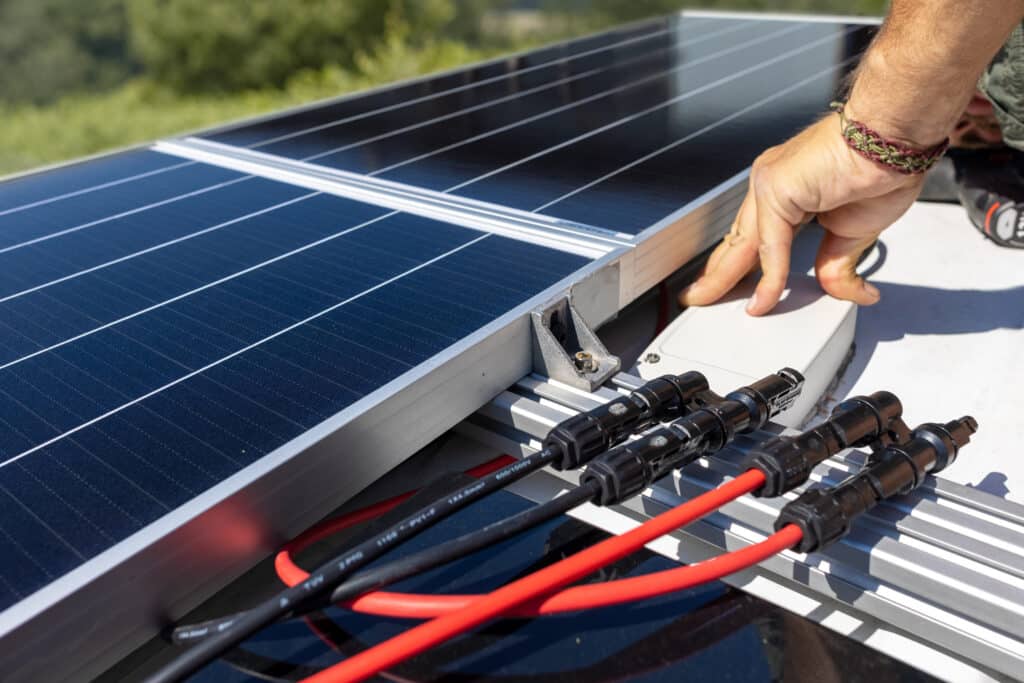What Are Solar Panels?
A solar panel, or photovoltaic (PV) panel, converts the sun’s energy into electricity. They’re most commonly composed of glass, wires and silicon and mounted on your rooftop or on the ground. Solar installations require a large number of panels to properly power your home. The configuration of solar panels, known as a solar array, depends on your home’s energy needs and available roof space.
Solar panels work best on cloudless days with ample sunshine exposure. Performance can be hindered by shadows covering the panels, cloudy days or night. The panels still work, but their ability to capture the sunlight is diminished.
The Photovoltaic Effect
The photovoltaic effect is key to how solar technology generates energy. This process begins when particles of sunlight, known as photons, knock electrons away from atoms. Electricity is created once these electrons are set into motion. Solar panels capture these electrical charges and convert them into electricity to power your home.
Each panel contains several interconnected photovoltaic cells (PV cells) made to capture sunlight. These PV cells are small, about 6 inches long by 6 inches wide. A solar panel contains between 32 and 48 PV cells but varies based on the panel’s size and intended output. Each cell uses nonmetal semiconductor material to absorb sunlight. Traditional solar photovoltaic panels use silicon, one of Earth’s most abundant elements.
However, silicon isn’t a great conductor on its own. Solar manufacturers use a process called “doping” to enhance its conductivity. This involves adding impurities that create bonds to the silicon to improve the electrical charge. Boron is added to create a positive charge while phosphorus creates a negative charge. Two layers of silicon are placed on top of each other, each treated with one of these elements. When brought together, they create an electrical field. Metal plates are added to the sides of the silicon solar cells to help push the electron through the wiring and into your home.
Solar Panel Materials
Most solar panel systems use crystalline silicon panels, some of the best solar panels for residential installations. PV panels are available in two options: monocrystalline and polycrystalline. Thin-film solar panels are a cheaper alternative to conventional panels and use thin layers of PV materials. Their manufacturing process and composition is different from traditional panels.
Monocrystalline (mono) panels use a pure form of single-crystalline silicon. This process is more expensive and time-consuming but results in higher power production. Polycrystalline panels are made with multiple silicon fragments, making manufacturing more cost-effective. However, these fragments create imperfections, lowering the panels’ efficiency. Thin-film panels are the cheapest to manufacture because they use thin PV materials instead of silicon, but they have the lowest energy production.
Solar Panel Efficiency
Efficiency measures how much sunlight a panel can absorb and convert into electricity. For example, solar panels with an efficiency rating of 16% can absorb 16% of the sun’s rays and convert them into energy. According to the National Renewable Energy Laboratory (NREL), most solar panels have efficiency ratings between 16% and 22%, with an average of 19.2%.
The pure silicon used in mono panels has no surface flaws, so these panels have the highest efficiency ratings, typically between 17% and 23%. Poly panels have a lower rating between 13% and 16%. Thin-film panels have the lowest efficiency ratings, with ranges between 7% and 11%.
How Do Solar Panels Work?
Solar panels are just the beginning of the electricity generation process. Beyond the panels, several other solar components help to power your home. We’ve provided a step-by-step breakdown of how solar energy systems work below.
- Solar cells absorb the photons: As sunlight hits solar panels, photons are absorbed into the solar cells. The photovoltaic effect takes place, converting the sunlight into an electric current. Solar electricity is initially converted into direct current electricity (DC electricity) but must be converted to alternating current electricity (AC electricity) to work in your home.
- A solar inverter converts DC energy to AC energy: Solar inverters convert DC electricity into AC electricity. String inverters are the most common type of inverter. They “string” together multiple solar panels for power conversion. Another option is microinverters, which attach to each solar panel. While more efficient, microinverters are more expensive.
- Usable energy flows to your home: After converting to AC electricity, the power travels to your main electrical panel and outlets. The power flows similarly to electricity from a grid system. Homeowners can choose to keep their solar system grid-tied to pull power when their solar panels aren’t in use. You can also choose to go off-grid and build a solar system big enough to run your home without utility company connections.
- A net meter monitors your power use: A net meter tracks any energy you pull from the grid during times when your solar panels aren’t available. The net meter also measures any excess electricity generated by your solar system. These devices are helpful for net-metering programs, which allow solar customers to sell their excess energy in exchange for utility bill credits or annual payouts. Program availability varies by state. You may also find these programs through your local utility companies.
- Solar batteries store your excess energy: If your energy production exceeds your home’s needs, extra energy can be stored in solar batteries. These are invaluable for homeowners looking to go off-grid or as an alternative to net-metering programs. The stored energy can be used during a blackout or when your solar panels are inactive. You can also use the stored energy to offset periods of high electricity rates, helping to lower your utility bills. Solar batteries are optional for new or current solar installations. Some of the best solar batteries come from popular solar manufacturers such as LG, SunPower and Tesla.
The Bottom Line: How Do Solar Panels Work?
Your solar system’s productivity begins with the panels. By choosing the right panels, components and accessories, you can maximize your money-saving potential. Knowing how solar panels work not only improves your knowledge as a consumer but makes you more informed in the buying process. To ensure you get the best solar panels available, compare at least three solar companies in your research. Use our tool below to begin your solar buying journey.
This post was originally published on 3rd party site mentioned in the title of this site






